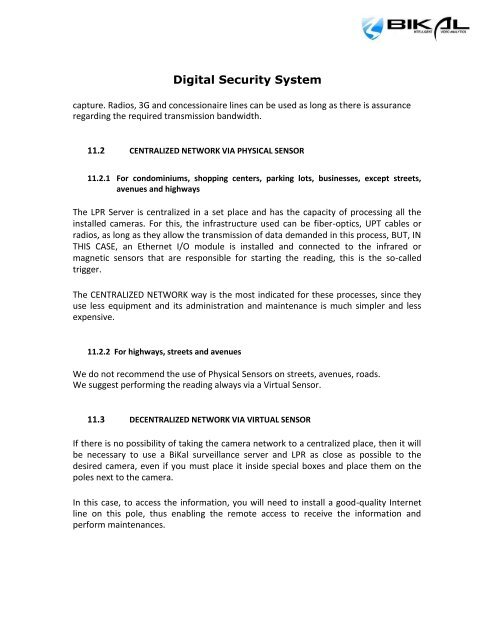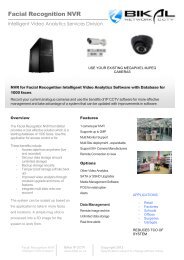Camera Positioning Tutorial - Bikal
Camera Positioning Tutorial - Bikal
Camera Positioning Tutorial - Bikal
Create successful ePaper yourself
Turn your PDF publications into a flip-book with our unique Google optimized e-Paper software.
Digital Security System<br />
capture. Radios, 3G and concessionaire lines can be used as long as there is assurance<br />
regarding the required transmission bandwidth.<br />
11.2 CENTRALIZED NETWORK VIA PHYSICAL SENSOR<br />
11.2.1 For condominiums, shopping centers, parking lots, businesses, except streets,<br />
avenues and highways<br />
The LPR Server is centralized in a set place and has the capacity of processing all the<br />
installed cameras. For this, the infrastructure used can be fiber-optics, UPT cables or<br />
radios, as long as they allow the transmission of data demanded in this process, BUT, IN<br />
THIS CASE, an Ethernet I/O module is installed and connected to the infrared or<br />
magnetic sensors that are responsible for starting the reading, this is the so-called<br />
trigger.<br />
The CENTRALIZED NETWORK way is the most indicated for these processes, since they<br />
use less equipment and its administration and maintenance is much simpler and less<br />
expensive.<br />
11.2.2 For highways, streets and avenues<br />
We do not recommend the use of Physical Sensors on streets, avenues, roads.<br />
We suggest performing the reading always via a Virtual Sensor.<br />
11.3 DECENTRALIZED NETWORK VIA VIRTUAL SENSOR<br />
If there is no possibility of taking the camera network to a centralized place, then it will<br />
be necessary to use a BiKal surveillance server and LPR as close as possible to the<br />
desired camera, even if you must place it inside special boxes and place them on the<br />
poles next to the camera.<br />
In this case, to access the information, you will need to install a good-quality Internet<br />
line on this pole, thus enabling the remote access to receive the information and<br />
perform maintenances.




